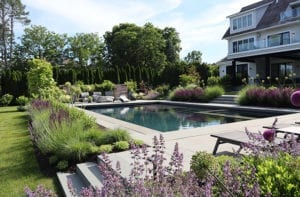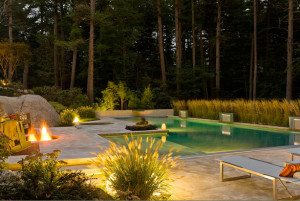A Cut Above
April 13, 2011
Text by Nena Donovan Levine
Block prints? I made one at camp.” Ridgefield artist Deborah Weiss sometimes gets that response when she mentions her work as a woodcut printmaker. But as anyone who sees Weiss’s creations realizes at once, they’re a far cry from a camper’s craft project. Those a bit more familiar with the medium will also recognize how much her work departs from traditional woodcut printmaking. Her fluid, diaphanous studies mingle and merge a dozen hues, bursting the constraints of the age-old form.
Weiss’s work resembles that of earlier printmaking masters, like Hans Holbein in the sixteenth century or Katsushika Hokusai in the nineteenth, about as much as Water Lilies resembles the Mona Lisa. Holbein printed and bordered his representational scenes in stark black ink; Weiss creates abstract imagery in lush tones. Though colorful, Hokusai’s work—even his well-known Great Wave—is static, motionless; Weiss’s woodcuts, by contrast, seem to ripple and flow across the page.
The form can be “very strict and rigid,” the artist acknowledges, “but I’ve turned it into something that’s freer and less restrained.”
A former graphic designer, Weiss fell in love with the medium a decade ago, inspired in part by her interest in handmade Asian papers, with their unpredictable thickness and random coloration. Today, she creates two distinct styles of woodcut prints. The first involves layering numerous printings with opaque and transparent inks to produce striking multi-hued abstractions. The artist’s Silk Road andWatermarked series exemplify this major facet of her output, whose textures and sense of movement evoke both the natural world and the layered, woven feel of textiles.
Weiss also works in another mode, using nontoxic inks to print botanical silhouettes on lokta, a handmade paper from Nepal. In these bold, hand-pulled prints, which Weiss has assembled in a separate collection called Green Print Portfolio, the silhouettes float among the mysterious, shadowy stains and blotchy freckles inherent to the organic paper.
As fluid and spontaneous as her art appears, a careful process underlies it. While each piece offers “an element of surprise,” Weiss says, “there are always technical issues that come into play.” Selecting the right wood species for the block is crucial, as the grain affects how much detail she can carve. Weiss typically turns to tight-grained Shina plywood, locally sourced luan or birch, or salvage wood, whose grain resembles rivulets and eddies. Carving time depends on the wood, but it’s never a quick job.
Using implements such as futatsu wari (Japanese precision tools), a large wood gouge and a small Dremel power tool, Weiss carves her patterns and images onto wood blocks that are larger than the paper. The technique allows her to position the sheet on different parts of the same block for multiple overprintings. She always makes the first printing in an opaque ink, adding subsequent layers in transparent hues. The artist has to reckon with how the colors will change when laid over each other, and how they’ll absorb—or not absorb—into the paper. Sometimes she cuts a full-size sheet into wide sections, which gives her greater freedom in placing the paper on the block, reassembling the sections to create the final work.
Weiss’s unique methods, which she honed at the Center for Contemporary Printmaking in Norwalk, have won her plenty of recognition. She has exhibited nationally, including at the International Print Center New York, as well as in China. Her work can be found in many private and corporate collections, such as those of Fidelity Investments, Unilever and the Ritz-Carlton and Four Seasons hotels. In November, Kean University in New Jersey will mount a solo show of Weiss’s woodcut artistry.
“We have had a terrific response to Deborah’s work,” says David Behnke, of Behnke Doherty Gallery in Washington Depot. “Her wonderful sense of color, manipulation of registration and use of the woodblock grain itself as part of her compositions . . . make her prints instantly recognizable.”
Indeed, whether or not they know anything about woodcut printmaking, people are drawn to Weiss’s abstract, nature-based imagery. “I hope viewers appreciate work that suggests rather than dictates,” she says. “When someone tells me that a particular print or series reminds them of something they have observed, I am pleased.”
Editor’s Note To see more of Weiss’s work, visit her Web site www.deborahweiss.com.
Share
![NEH-Logo_Black[1] NEH-Logo_Black[1]](https://www.nehomemag.com/wp-content/uploads/2022/08/NEH-Logo_Black1-300x162.jpg)













You must be logged in to post a comment.